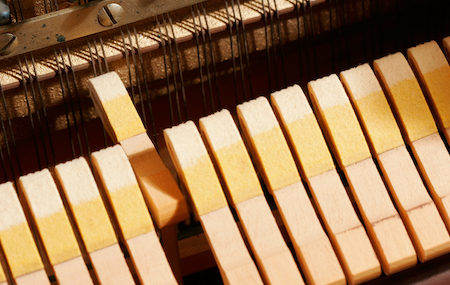For many beginners, a piano is just an instrument … until they sit down and start to play. As you touch the keys, you can feel the various parts working together. Peek under the lid, and you’ll find an intricate display of wood and metal, all helping to create a sound like no other.
It should come as no surprise that a modern piano has over 10,000 parts. If even one of those parts isn’t working well, it can compromise your overall sound. And that means you won’t enjoy making music and may lose the pleasure of playing!
While you don’t need to build a piano to appreciate its complexities, a general understanding of the anatomy of the piano can help you be a better player. Learning the various piano parts and their function can help you discover a greater love for making music.
The piano is a complex musical instrument that produces beautiful and rich sounds. It is composed of many different parts, each with a specific function that contributes to the instrument’s overall sound. Are you ready to explore the major components and discover how they help create better sound?
Casing and Lid
The casing and lid of a piano are essential in protecting the internal components of the piano from damage and environmental factors such as dust and humidity. The lid on a grand piano helps control the sound, as it can be opened or closed to alter the room’s acoustics. A closed lid produces a mellow sound, while an open top produces a brighter and more resonant sound.
Keyboard
The keyboard is the most recognizable part of a piano and is where every pianist gravitates, knowing this is how to produce music. A standard piano keyboard has 88 keys, each making a different note when pressed. The keys are weighted and balanced to provide a consistent feel and response, essential for precision playing and expression.
Soundboard
The soundboard is a large wooden panel that amplifies and resonates with the sound produced by the piano strings. It is responsible for creating the characteristic sound of a piano and must be carefully crafted to ensure optimal sound quality. The shape and curvature of the soundboard are critical factors in determining the tone and quality of the sound produced by the piano.
Hammers
The hammers are felt-covered mechanisms that strike the strings when a key is pressed. They are responsible for creating the initial sound of the piano and must be carefully adjusted to ensure optimal sound quality. The hammers’ weight, shape, and density affect the sound produced by the piano and can be adjusted to alter the tone and timbre of the instrument.
Strings
The strings are thin wires stretched tightly across the piano’s body and struck by the hammers to produce sound. The strings are made from high-quality steel wire and must be carefully tensioned to ensure optimal sound quality. The strings’ length, thickness, and tension all affect the sound produced by the piano and can be adjusted to alter the pitch and tone of the instrument.
Bridge
The bridge is a wooden structure that anchors the strings to the soundboard and helps transmit the sound vibrations to the soundboard. It is responsible for sending the sound produced by the strings to the soundboard and is critical in creating the characteristic sound of a piano. The shape and placement of the bridge are essential factors in determining the tone and quality of the sound produced by the instrument.
Tuning Pins
The tuning pins are metal pins that hold the strings in place and allow the pianist to adjust the tension and pitch of the strings. They must be carefully adjusted to ensure the piano is in tune and produces optimal sound quality. The tuning pins are essential, as they allow for precise tuning and control over the sound produced by the instrument.
Pedals
The pedals are three foot-operated levers located at the base of the piano designed to control various sound effects and sustain notes. The sustain pedal is the most commonly used, allowing the pianist to sustain notes longer. The other pedals can produce different sound results, such as softening or brightening the sound produced by the piano. Pedals are essential for pianists, as they allow for greater expression and control over the sound produced by the instrument.
A better understanding makes a better piano player …
The careful craftsmanship made to each piano component ensures optimal sound quality and responsiveness. Pianists must also learn to use the various parts of the instrument to their fullest potential, controlling the sound produced by the piano with precision and expression.
Overall, the piano is an incredible instrument with a rich history and legacy. Its complex components work harmoniously to produce beautiful sounds and provide a canvas for pianists to create art and express themselves through music.
Whether you are a seasoned pianist or a beginner, understanding the major components of a piano and how they contribute to the sound of the instrument is essential for appreciating the artistry and craftsmanship that goes into creating this incredible musical instrument.


